湖南省2017年中考英语总复习语法课件:专题2 代词
文档属性
| 名称 | 湖南省2017年中考英语总复习语法课件:专题2 代词 | 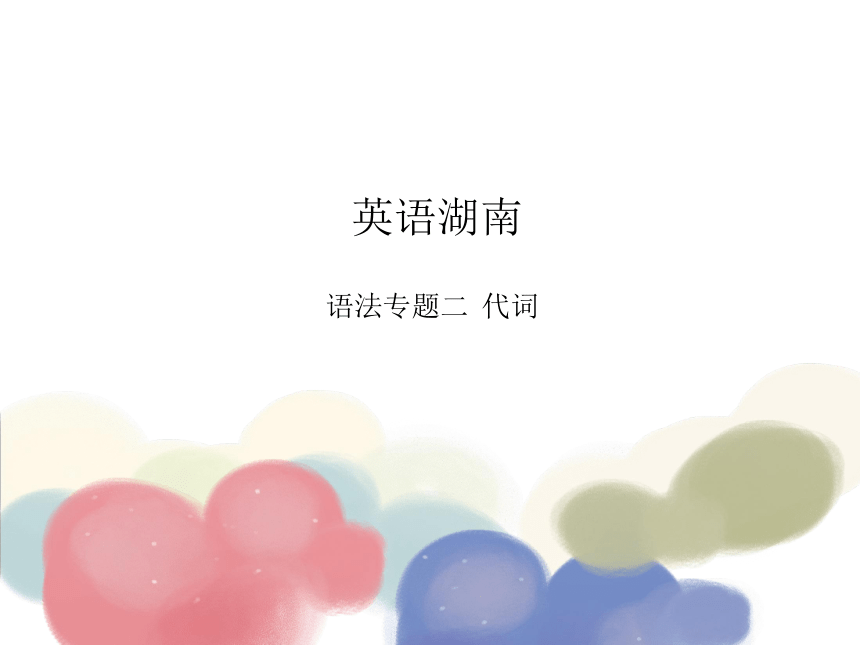 | |
| 格式 | zip | ||
| 文件大小 | 2.1MB | ||
| 资源类型 | 教案 | ||
| 版本资源 | 通用版 | ||
| 科目 | 英语 | ||
| 更新时间 | 2017-05-26 22:09:21 | ||
图片预览

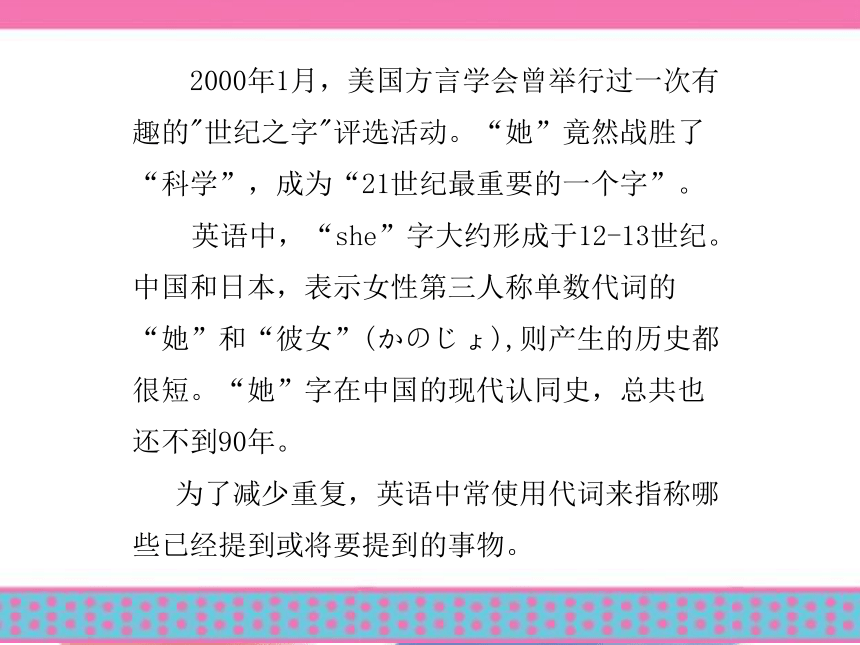
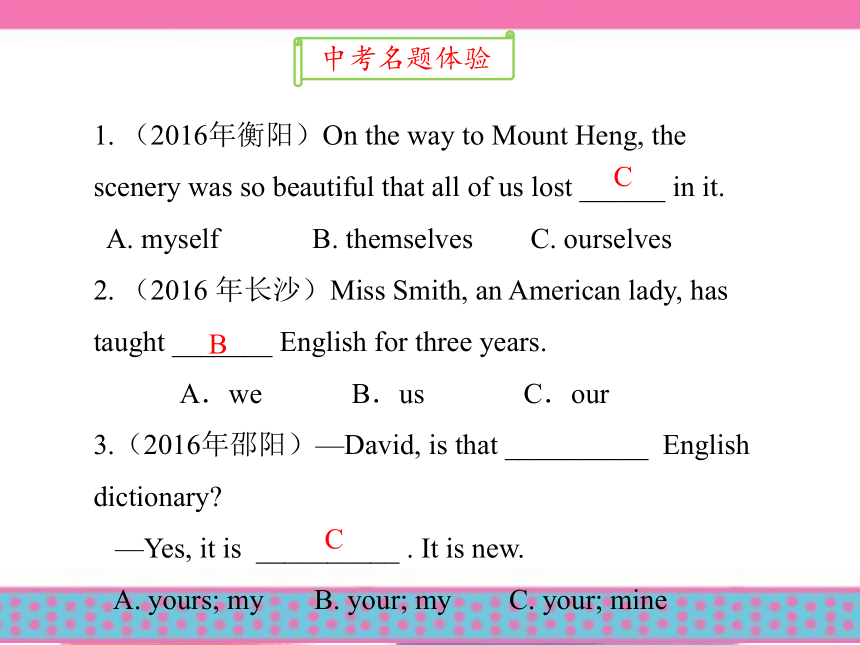
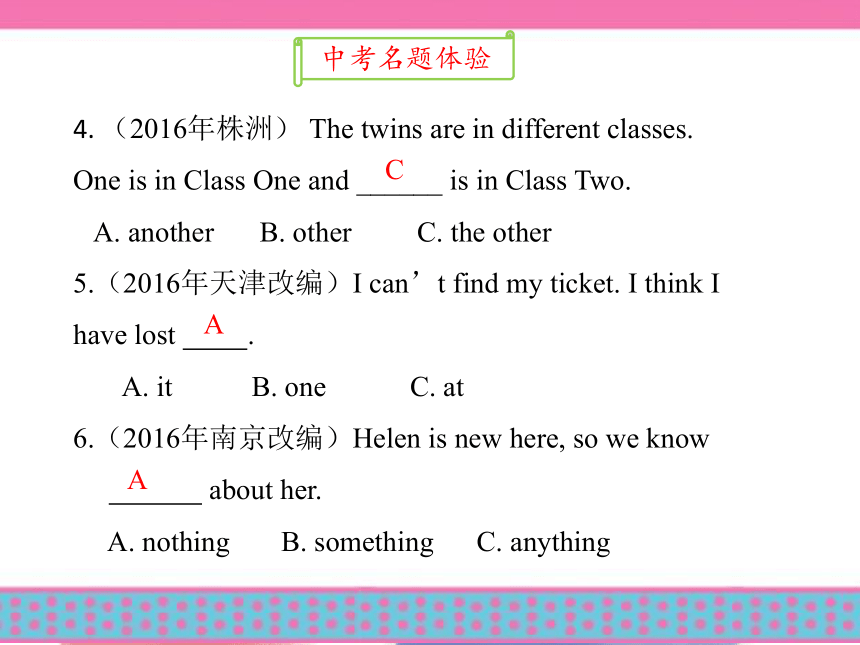

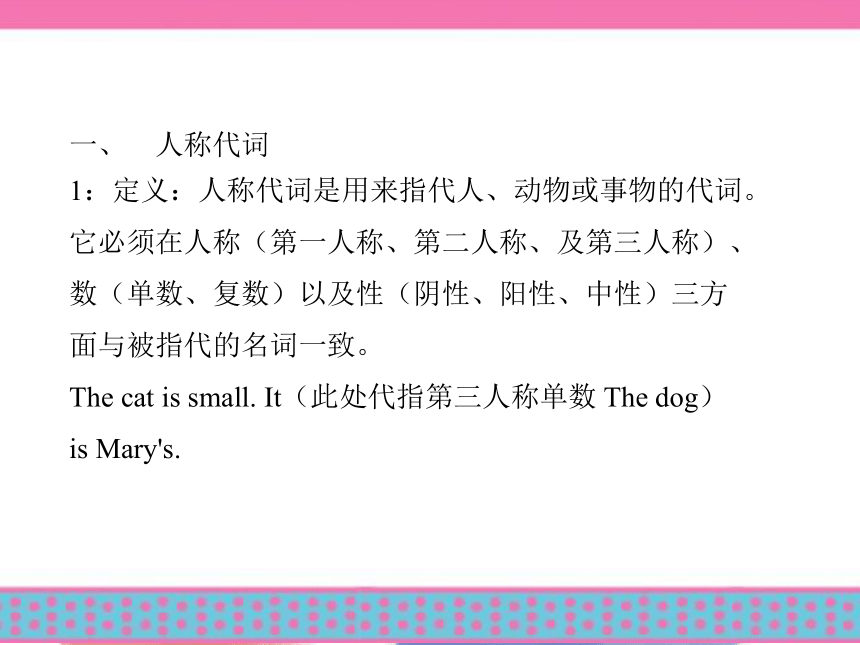
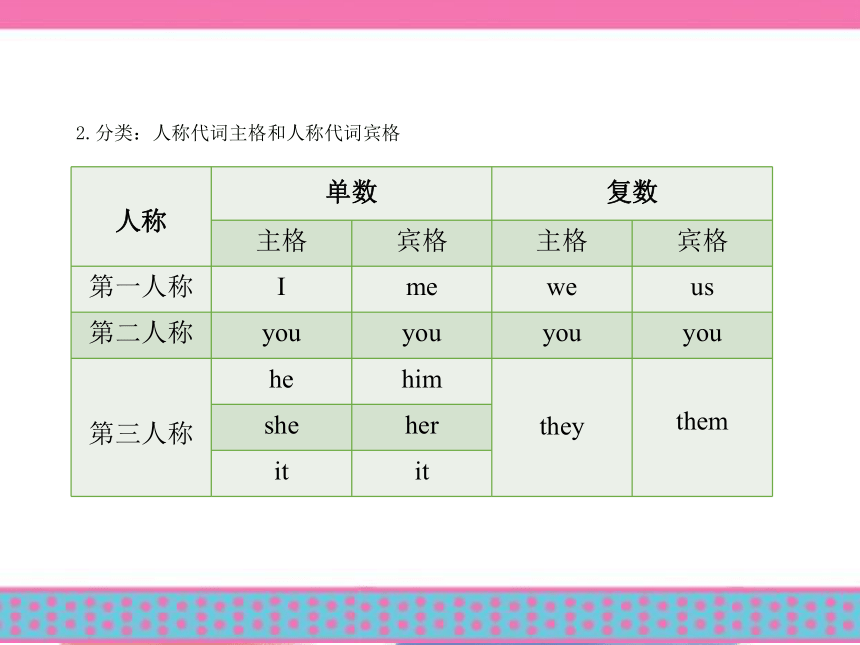
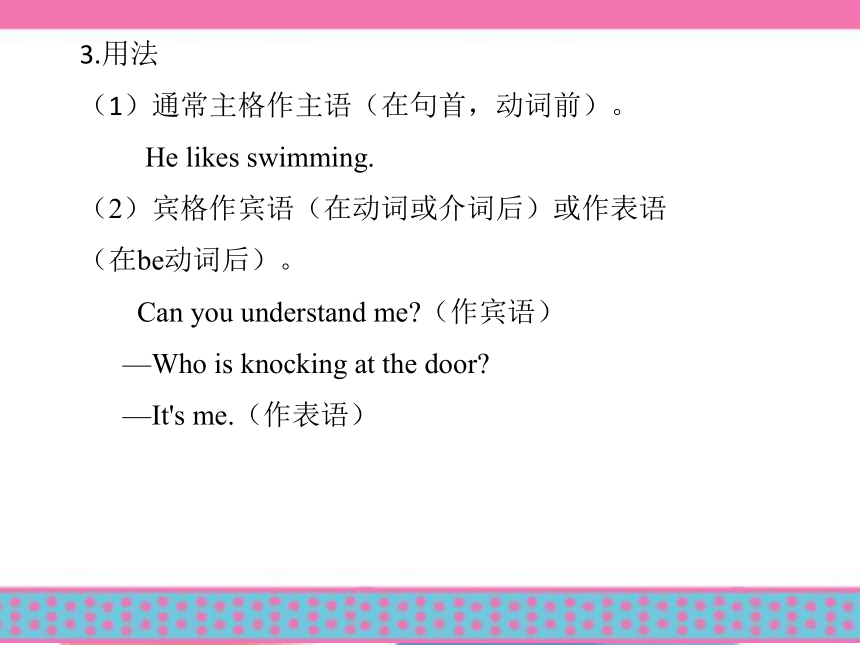
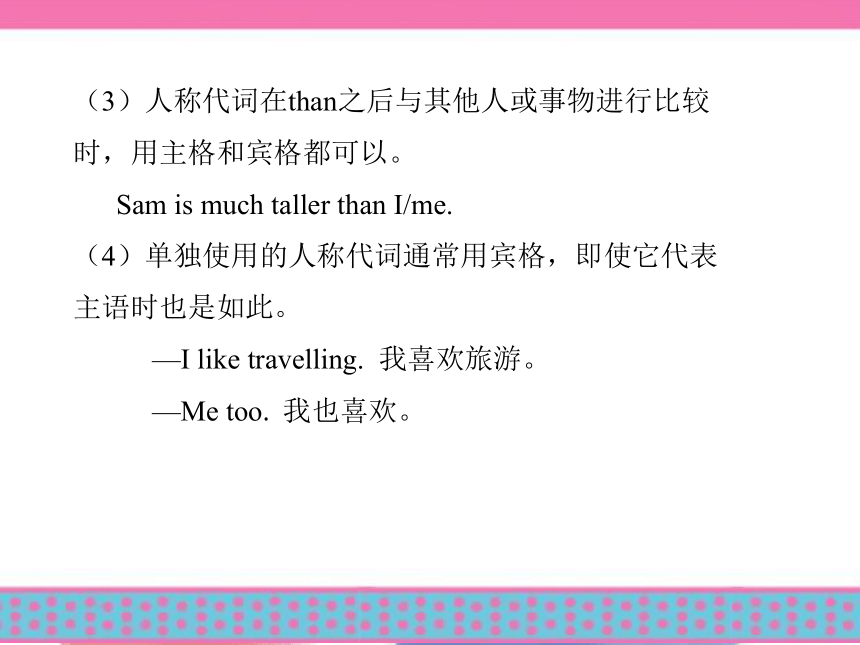
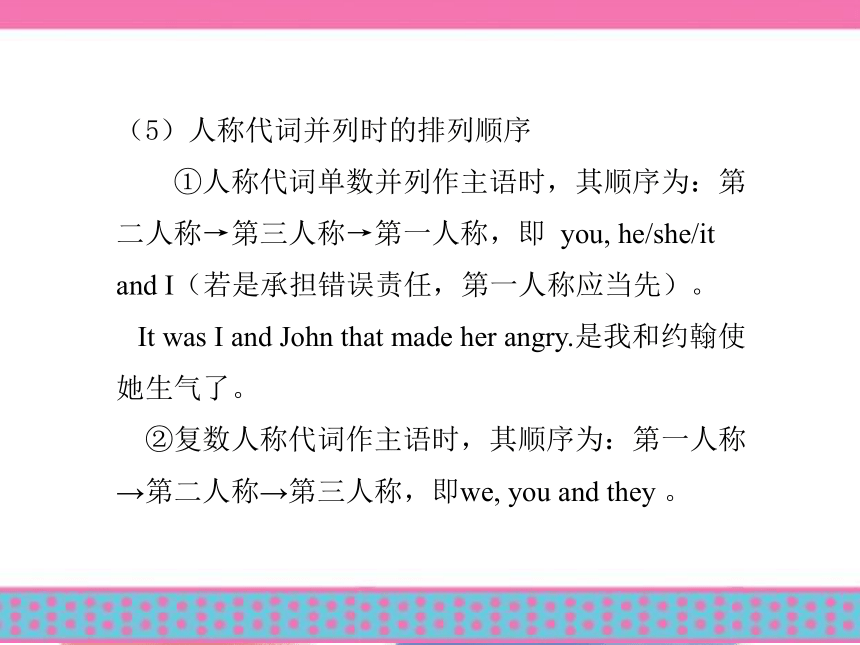
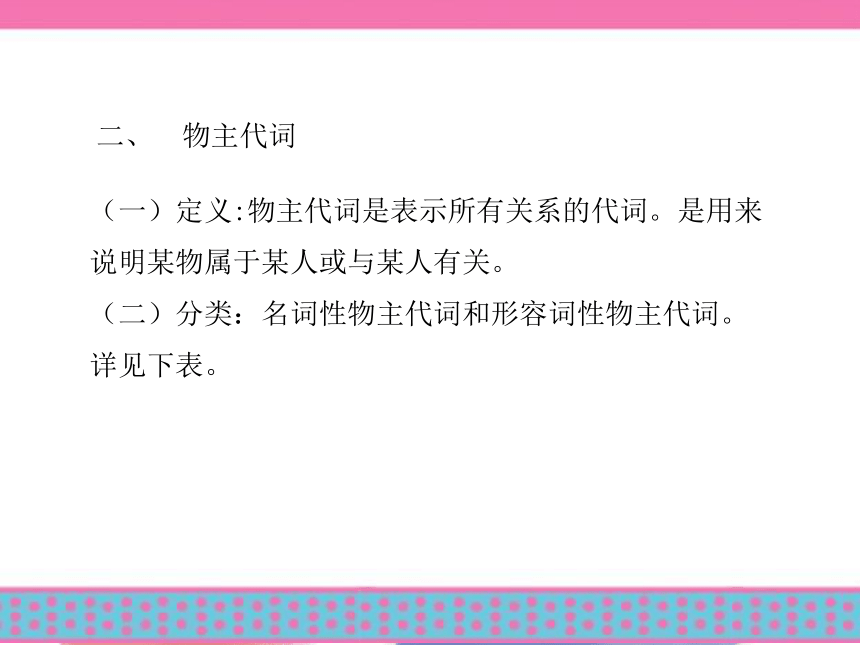
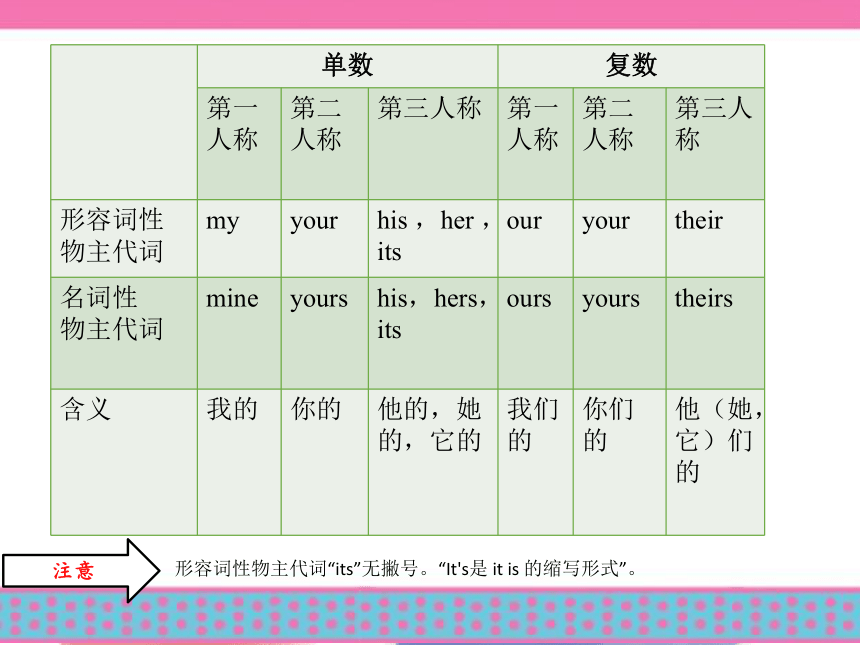
文档简介
课件37张PPT。 英语湖南
语法专题二 代词 2000年1月,美国方言学会曾举行过一次有趣的"世纪之字"评选活动。“她”竟然战胜了“科学”,成为“21世纪最重要的一个字”。
英语中,“she”字大约形成于12-13世纪。中国和日本,表示女性第三人称单数代词的“她”和“彼女”(かのじょ),则产生的历史都很短。“她”字在中国的现代认同史,总共也还不到90年。
为了减少重复,英语中常使用代词来指称哪些已经提到或将要提到的事物。中考名题体验1. (2016年衡阳)On the way to Mount Heng, the scenery was so beautiful that all of us lost ______ in it.
A. myself B. themselves C. ourselves
2. (2016 年长沙)Miss Smith, an American lady, has taught _______ English for three years.
A.we B.us C.our
3.(2016年邵阳)—David, is that __________ English dictionary?
—Yes, it is __________ . It is new.
A. yours; my B. your; my C. your; mine
CBC4. (2016年株洲) The twins are in different classes. One is in Class One and ______ is in Class Two.
A. another B. other C. the other
5.(2016年天津改编)I can’t find my ticket. I think I have lost .
A. it B. one C. at
6.(2016年南京改编)Helen is new here, so we know
about her.
A. nothing B. something C. anything
中考名题体验C AA语法探究一、 人称代词 1:定义:人称代词是用来指代人、动物或事物的代词。它必须在人称(第一人称、第二人称、及第三人称)、数(单数、复数)以及性(阴性、阳性、中性)三方面与被指代的名词一致。
The cat is small. It(此处代指第三人称单数 The dog) is Mary's.2.分类:人称代词主格和人称代词宾格3.用法
(1)通常主格作主语(在句首,动词前)。
He likes swimming.
(2)宾格作宾语(在动词或介词后)或作表语(在be动词后)。
Can you understand me?(作宾语)
—Who is knocking at the door?
—It's me.(作表语)
(3)人称代词在than之后与其他人或事物进行比较时,用主格和宾格都可以。
Sam is much taller than I/me.
(4)单独使用的人称代词通常用宾格,即使它代表主语时也是如此。
—I like travelling. 我喜欢旅游。
—Me too. 我也喜欢。(5)人称代词并列时的排列顺序
①人称代词单数并列作主语时,其顺序为:第二人称→第三人称→第一人称,即 you, he/she/it and I(若是承担错误责任,第一人称应当先)。
It was I and John that made her angry.是我和约翰使她生气了。
②复数人称代词作主语时,其顺序为:第一人称→第二人称→第三人称,即we, you and they 。
二、 物主代词 (一)定义:物主代词是表示所有关系的代词。是用来说明某物属于某人或与某人有关。
(二)分类:名词性物主代词和形容词性物主代词。详见下表。注意 形容词性物主代词“its”无撇号。“It's是 it is 的缩写形式”。 (三)用法
(1)形容词性物主代词相当于形容词,只能放在名词前作定语,后面一定要跟一个名词。如:my book、your name,their hobbies。
①放在被拥有的物体名词前,指明事物的归属者。
My book is on the desk. 我的书在桌子上。
②放在被拥有的事物名词前,表示事物与某人有某种联系。
He is my younger brother。他是我的弟弟。 ③用于描述说话人对自己所做的事情或某人对某人 自己所做的事情。。
She is brushing her teeth. 她正在刷牙。
④放在表示动作的名词之前,指明动作的施行者。
not long after our arrival (在我们到达后不久)
⑤放在表示动作的名词之前,指明动作的承受者。
Jim and his supporters (吉姆和他的支持者们)
⑥用于头衔
Your Majesty(陛下)
Would Your Highness like a cup of tea.阁下想要一杯茶吗?注:a. 形容词性物主代词的选择应根据事物的所有者的“人称”(第一、二、三人称)和“数”(单、复数)来确定。
b. 形容词性物主代词通常修饰有生命的事物,如 “the door"或”“the door of the room ”比 “its door ”更常见。
c. 表示某物属于某人或某物,或者与某人某物有关还可以名词所有格或“of +介词短语”表示。
(2)名词性物主代词相当于名词,后面不能加名词,可单独使用,可在句中充当主语,宾语,表语等。相当于“形容词性物主代词+名词”。
①用于说明某事物与刚提及的事物类别相同,但属于其他人。
Sarah's house is much bigger than ours.萨拉的房子比我们的房子要大很多。
②常用于“of”引出的介词短语,表示所谈及的是群体中的一员。
a friend of mine 我的一个朋友 (表示许多朋友中的一个)
三、反身代词 英语中用来表示"我自己"、"你自己"、"他自己"、"我们自己"、"你们自己"、"他/她/它们自己"等意义的代词称为反身代词。反身代词可以在句中作宾语、表语和同位语。
1.作宾语,表示动作的承受者就是动作的发出者,主语和宾语指同一个人或一些人。
He enjoyed himself in the wild . 他在野外玩的很开心。
2.作表语。
It doesn't matter.I'll be myself soon.
不要紧。我很快就会恢复好。
3.作主语或宾语的同位语,意为“亲自”。主要用于加强语气,可紧放在被修饰名词后或句末。
She herself went to the school.(=She went to the school herself.)(作主语同位语)
You should ask the teacher himself.(作宾语同位语)
4.常用短语:by oneself 亲自;独自
enjoy oneself 玩得开心
dress oneself 自己穿衣服
teach oneself 自学
四、指示代词(一)定义:表示“这个”、“那个”、“这些”、“那些”等指示概念的代词叫指示代词。(二)用法
指示代词可在句中作主语、宾语、表语、定语等。
1. that 和 those 代替前面提到的东西,以避免重复这个名词。
My seat is next to that of the mayor.(that=mayor's seat) 我的座位在市长座位旁边。
2. this 或 that用来回指上文提到的事情时,但是若要指下文叙述的事情,通常要用 this。
—She is a beautiful girl.他是一个漂亮的女孩。
—Who said that? 那是谁说的?
I want to know this: Is she beautiful? 我想知道这一点:她美吗?
3. 在打电话时,通常用 this 指自己,用that指对方:
Hello. This is Jim. Is that John?喂,我是吉姆,你是约翰吗?4. 指示代词this, that 和these在作主语时可指物也可指人,但作其他句子成分时只能指物,不能指人。而those作宾语后接定语从句时可以指人。而且只有that、those后面可以跟定语从句。五、 不定代词(一)定义:不指明代替任何特定名词或形容词的代词叫做不定代词。
常见不定代词如下表所示:
(二)用法
1.some 和any既可代替或修饰可数名词复数,也可代替或修饰不可数名词。some多用于肯定句,any 则多用于否定句、疑问句和条件从句。
--Are there any oranges in the fridge?
--Yes,there are some./No,there aren't any.
--Is there any water in the bottle?
--Yes,there is some water./No,there isn't any water.注意 在 Would you like some tea?这类问句中则用some,而不用any, 这是因为问话者希望得到对方肯定的答复。
2.many 和much均表示“很多”。但many 只代替或修饰可数名词复数,而much只代替或修饰不可数名词。
There are many people in the supermarket on weekends.周末,超市有许多人。
I don't have much money with me.我没带多少钱。
Don't take so many.别拿那么多。
—Got any money?(有钱吗?)
—Not much.(不多) 3.few 与 a few 代替或修饰可数名词复数;little 与a little代替或修饰不可数名词。few 和little意为“很少;几乎没有”,有“否定”的含义;a few 和 a little意为“有一些”,是“肯定”的含义。
There is little milk on the bottle.
There is a little milk on the bottle.You can still drink it.
Few people know about this.
There is now little hope of success. 4.由some,any,no,every构成的复合不定代词做主语时,都作单数看待,其谓语动词用第三人称单数形式。
Anything is possible.
Something is wrong with my watch.
5.不定代词若有定语修饰,该定语要置于其后。
Would you like something to drink?
Is there anything wrong?
考点六 疑问代词 疑问代词包括who 、whose、whom、what、which。
1.如果答句是人,可用疑问代词who、whose和 whom。who作句子的主语、表语或宾语。whom一般作句子的宾语,也可作主语。whose既可句子的主语,宾语,也可以作定语。
Who was at the door?
—There is a car outside.
-—whose is it?
What are you doing?
Which came first, the chicken or the egg? 2.如果答语是事物而不是人,用疑问代词which 和 what。which 是有特定范围的选择,而what不指定范围。
Which season do you like best?(一年有四季)
Which do you like better , apple or banana?(从苹果和香蕉中选择)
What do you want to drink?专项集训1.—Is this ______ bike?
—No, it’s Lily’s. ______ is over there.
A. your; My B. your; Mine
C yours; Mine
2. In our school, ______ students like English, but ______ of them can speak English smoothly.
A. a little; a few B. a few; few
C. a few, little
BB3.—Susan, go and join your sister in cleaning the yard.
—Why ______? John is sitting there doing nothing at all.
A. I B. me C. myself
4.—This book on idioms is interesting. I’d like ______, where did you buy it, Simon?
—In the Amazon Bookstore.
A. it B. this C. one
BC5.We have friends to help us fight against pollution, and trees are one of ________.
A. themselves B. they C. them
6.We must protect plants. They are friends of ______.
A.ours B. us C. our
7.You can take _ _____ of the two toy cars and leave the other for your brother.
A. both B. none C. either D. neither
CAC
8.At present, children mean _______ to most parents in China.
A. everything B. nothing
C. anything
9.It’s possible to get $100 a day in this company, and some days you can get
_______.
A. much B. more
C. little
AB10.Don’t worry. We’re old enough to look after ______.
A. myself B. me C. ourselves
11.—Is this _______ ruler?
—No. _______ is over there.
A. her; Her B. her; Hers
C. hers; Hers
C B
语法专题二 代词 2000年1月,美国方言学会曾举行过一次有趣的"世纪之字"评选活动。“她”竟然战胜了“科学”,成为“21世纪最重要的一个字”。
英语中,“she”字大约形成于12-13世纪。中国和日本,表示女性第三人称单数代词的“她”和“彼女”(かのじょ),则产生的历史都很短。“她”字在中国的现代认同史,总共也还不到90年。
为了减少重复,英语中常使用代词来指称哪些已经提到或将要提到的事物。中考名题体验1. (2016年衡阳)On the way to Mount Heng, the scenery was so beautiful that all of us lost ______ in it.
A. myself B. themselves C. ourselves
2. (2016 年长沙)Miss Smith, an American lady, has taught _______ English for three years.
A.we B.us C.our
3.(2016年邵阳)—David, is that __________ English dictionary?
—Yes, it is __________ . It is new.
A. yours; my B. your; my C. your; mine
CBC4. (2016年株洲) The twins are in different classes. One is in Class One and ______ is in Class Two.
A. another B. other C. the other
5.(2016年天津改编)I can’t find my ticket. I think I have lost .
A. it B. one C. at
6.(2016年南京改编)Helen is new here, so we know
about her.
A. nothing B. something C. anything
中考名题体验C AA语法探究一、 人称代词 1:定义:人称代词是用来指代人、动物或事物的代词。它必须在人称(第一人称、第二人称、及第三人称)、数(单数、复数)以及性(阴性、阳性、中性)三方面与被指代的名词一致。
The cat is small. It(此处代指第三人称单数 The dog) is Mary's.2.分类:人称代词主格和人称代词宾格3.用法
(1)通常主格作主语(在句首,动词前)。
He likes swimming.
(2)宾格作宾语(在动词或介词后)或作表语(在be动词后)。
Can you understand me?(作宾语)
—Who is knocking at the door?
—It's me.(作表语)
(3)人称代词在than之后与其他人或事物进行比较时,用主格和宾格都可以。
Sam is much taller than I/me.
(4)单独使用的人称代词通常用宾格,即使它代表主语时也是如此。
—I like travelling. 我喜欢旅游。
—Me too. 我也喜欢。(5)人称代词并列时的排列顺序
①人称代词单数并列作主语时,其顺序为:第二人称→第三人称→第一人称,即 you, he/she/it and I(若是承担错误责任,第一人称应当先)。
It was I and John that made her angry.是我和约翰使她生气了。
②复数人称代词作主语时,其顺序为:第一人称→第二人称→第三人称,即we, you and they 。
二、 物主代词 (一)定义:物主代词是表示所有关系的代词。是用来说明某物属于某人或与某人有关。
(二)分类:名词性物主代词和形容词性物主代词。详见下表。注意 形容词性物主代词“its”无撇号。“It's是 it is 的缩写形式”。 (三)用法
(1)形容词性物主代词相当于形容词,只能放在名词前作定语,后面一定要跟一个名词。如:my book、your name,their hobbies。
①放在被拥有的物体名词前,指明事物的归属者。
My book is on the desk. 我的书在桌子上。
②放在被拥有的事物名词前,表示事物与某人有某种联系。
He is my younger brother。他是我的弟弟。 ③用于描述说话人对自己所做的事情或某人对某人 自己所做的事情。。
She is brushing her teeth. 她正在刷牙。
④放在表示动作的名词之前,指明动作的施行者。
not long after our arrival (在我们到达后不久)
⑤放在表示动作的名词之前,指明动作的承受者。
Jim and his supporters (吉姆和他的支持者们)
⑥用于头衔
Your Majesty(陛下)
Would Your Highness like a cup of tea.阁下想要一杯茶吗?注:a. 形容词性物主代词的选择应根据事物的所有者的“人称”(第一、二、三人称)和“数”(单、复数)来确定。
b. 形容词性物主代词通常修饰有生命的事物,如 “the door"或”“the door of the room ”比 “its door ”更常见。
c. 表示某物属于某人或某物,或者与某人某物有关还可以名词所有格或“of +介词短语”表示。
(2)名词性物主代词相当于名词,后面不能加名词,可单独使用,可在句中充当主语,宾语,表语等。相当于“形容词性物主代词+名词”。
①用于说明某事物与刚提及的事物类别相同,但属于其他人。
Sarah's house is much bigger than ours.萨拉的房子比我们的房子要大很多。
②常用于“of”引出的介词短语,表示所谈及的是群体中的一员。
a friend of mine 我的一个朋友 (表示许多朋友中的一个)
三、反身代词 英语中用来表示"我自己"、"你自己"、"他自己"、"我们自己"、"你们自己"、"他/她/它们自己"等意义的代词称为反身代词。反身代词可以在句中作宾语、表语和同位语。
1.作宾语,表示动作的承受者就是动作的发出者,主语和宾语指同一个人或一些人。
He enjoyed himself in the wild . 他在野外玩的很开心。
2.作表语。
It doesn't matter.I'll be myself soon.
不要紧。我很快就会恢复好。
3.作主语或宾语的同位语,意为“亲自”。主要用于加强语气,可紧放在被修饰名词后或句末。
She herself went to the school.(=She went to the school herself.)(作主语同位语)
You should ask the teacher himself.(作宾语同位语)
4.常用短语:by oneself 亲自;独自
enjoy oneself 玩得开心
dress oneself 自己穿衣服
teach oneself 自学
四、指示代词(一)定义:表示“这个”、“那个”、“这些”、“那些”等指示概念的代词叫指示代词。(二)用法
指示代词可在句中作主语、宾语、表语、定语等。
1. that 和 those 代替前面提到的东西,以避免重复这个名词。
My seat is next to that of the mayor.(that=mayor's seat) 我的座位在市长座位旁边。
2. this 或 that用来回指上文提到的事情时,但是若要指下文叙述的事情,通常要用 this。
—She is a beautiful girl.他是一个漂亮的女孩。
—Who said that? 那是谁说的?
I want to know this: Is she beautiful? 我想知道这一点:她美吗?
3. 在打电话时,通常用 this 指自己,用that指对方:
Hello. This is Jim. Is that John?喂,我是吉姆,你是约翰吗?4. 指示代词this, that 和these在作主语时可指物也可指人,但作其他句子成分时只能指物,不能指人。而those作宾语后接定语从句时可以指人。而且只有that、those后面可以跟定语从句。五、 不定代词(一)定义:不指明代替任何特定名词或形容词的代词叫做不定代词。
常见不定代词如下表所示:
(二)用法
1.some 和any既可代替或修饰可数名词复数,也可代替或修饰不可数名词。some多用于肯定句,any 则多用于否定句、疑问句和条件从句。
--Are there any oranges in the fridge?
--Yes,there are some./No,there aren't any.
--Is there any water in the bottle?
--Yes,there is some water./No,there isn't any water.注意 在 Would you like some tea?这类问句中则用some,而不用any, 这是因为问话者希望得到对方肯定的答复。
2.many 和much均表示“很多”。但many 只代替或修饰可数名词复数,而much只代替或修饰不可数名词。
There are many people in the supermarket on weekends.周末,超市有许多人。
I don't have much money with me.我没带多少钱。
Don't take so many.别拿那么多。
—Got any money?(有钱吗?)
—Not much.(不多) 3.few 与 a few 代替或修饰可数名词复数;little 与a little代替或修饰不可数名词。few 和little意为“很少;几乎没有”,有“否定”的含义;a few 和 a little意为“有一些”,是“肯定”的含义。
There is little milk on the bottle.
There is a little milk on the bottle.You can still drink it.
Few people know about this.
There is now little hope of success. 4.由some,any,no,every构成的复合不定代词做主语时,都作单数看待,其谓语动词用第三人称单数形式。
Anything is possible.
Something is wrong with my watch.
5.不定代词若有定语修饰,该定语要置于其后。
Would you like something to drink?
Is there anything wrong?
考点六 疑问代词 疑问代词包括who 、whose、whom、what、which。
1.如果答句是人,可用疑问代词who、whose和 whom。who作句子的主语、表语或宾语。whom一般作句子的宾语,也可作主语。whose既可句子的主语,宾语,也可以作定语。
Who was at the door?
—There is a car outside.
-—whose is it?
What are you doing?
Which came first, the chicken or the egg? 2.如果答语是事物而不是人,用疑问代词which 和 what。which 是有特定范围的选择,而what不指定范围。
Which season do you like best?(一年有四季)
Which do you like better , apple or banana?(从苹果和香蕉中选择)
What do you want to drink?专项集训1.—Is this ______ bike?
—No, it’s Lily’s. ______ is over there.
A. your; My B. your; Mine
C yours; Mine
2. In our school, ______ students like English, but ______ of them can speak English smoothly.
A. a little; a few B. a few; few
C. a few, little
BB3.—Susan, go and join your sister in cleaning the yard.
—Why ______? John is sitting there doing nothing at all.
A. I B. me C. myself
4.—This book on idioms is interesting. I’d like ______, where did you buy it, Simon?
—In the Amazon Bookstore.
A. it B. this C. one
BC5.We have friends to help us fight against pollution, and trees are one of ________.
A. themselves B. they C. them
6.We must protect plants. They are friends of ______.
A.ours B. us C. our
7.You can take _ _____ of the two toy cars and leave the other for your brother.
A. both B. none C. either D. neither
CAC
8.At present, children mean _______ to most parents in China.
A. everything B. nothing
C. anything
9.It’s possible to get $100 a day in this company, and some days you can get
_______.
A. much B. more
C. little
AB10.Don’t worry. We’re old enough to look after ______.
A. myself B. me C. ourselves
11.—Is this _______ ruler?
—No. _______ is over there.
A. her; Her B. her; Hers
C. hers; Hers
C B
同课章节目录
- 词法
- 名词
- 动词和动词短语
- 动词语态
- 动词时态
- 助动词和情态动词
- 非谓语动词
- 冠词
- 代词
- 数词和量词
- 形容词副词及其比较等级
- 介词和介词短语
- 连词和感叹词
- 构词法
- 相似、相近词比较
- 句法
- 陈述句
- 一般疑问句和否定疑问句
- 特殊疑问句及选择疑问句
- 反意疑问句
- 存在句(There be句型)
- 宾语从句
- 定语从句
- 状语从句
- 主谓一致问题
- 简单句
- 并列句
- 复合句
- 主谓一致
- 主、表语从句
- 名词性从句
- 直接引语和间接引语
- 虚拟语气
- 感叹句
- 强调句
- 倒装句
- 祈使句
- 句子的成分
- 句子的分类
- 题型专区
- 单项选择部分
- 易错题
- 完形填空
- 阅读理解
- 词汇练习
- 听说训练
- 句型转换
- 补全对话
- 短文改错
- 翻译
- 书面表达
- 任务型阅读
- 语法填空
- 其他资料
